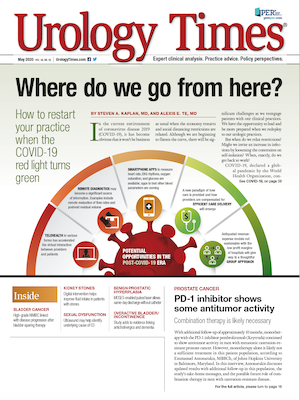Publication
Article
Urology Times Journal
Pre-chemo radium-223 does not affect chemo regimens
Author(s):
In a recent study, researchers examined real-world outcomes for patients with metastatic castration-resistant prostate cancer treated with radium-223 (Xofigo). Study author Rana R. McKay, MD, of UC San Diego Health, discusses this study and its significance in the castration-resistant prostate cancer landscape.

In a study presented at the 2020 Genitourinary Cancers Symposium, researchers examined real-world outcomes for patients with metastatic castration-resistant prostate cancer treated with radium-223 (Xofigo). Study author Rana R. McKay, MD, assistant professor of medicine at UC San Diego Health, discusses this study and its significance in the castration-resistant prostate cancer landscape.
Q: Please discuss the rationale for this study.
A: Radium-223 is a liquid radiopharmaceutical that has been shown to improve survival in patients with advanced prostate cancer. It’s specifically used for patients who have bone metastases, may have symptomatic bone pain, and don’t have visceral metastases. Results from the ALSYMPCA trial demonstrated the improvement of overall survival with this agent.
However, there’s not really been a lot of real-world data documenting how this agent is used in the changing landscape for metastatic castration-resistant prostate cancer. Since the ALSYMPCA trial, we’ve seen approvals of several androgen receptor (AR)-targeting agents and potentially PARP inhibition in the future, so placing radium-223 in the context of real-world practice has not really been established. The rationale for this study was to characterize the utilization of radium-223 within the real world.
Q: What did the results of the study show about the timing of initiating radium-223?
A: In the study, we included a total of 220 patients who had received radium between 2013 and 2017. We wanted to look at the characteristics of those patients who had received radium pre chemotherapy versus post chemotherapy. About half of our patients had received radium pre and half post chemotherapy on average.
We showed that when radium-223 was given prior to chemotherapy, it did not influence the amount of chemotherapy that any individual patient could receive. There have been some data suggesting that if you give radium pre chemo, their counts may not be sustained or they may have reasons for them to not actually receive all cycles of chemotherapy. In our data, we demonstrated that the median number of chemotherapy cycles given when radium was given either pre or post chemotherapy was 9 for both groups, and it did not seem that radium affected how much chemotherapy any one patient was able to receive.
The other thing we showed was that if radium was given pre chemotherapy as opposed to post chemotherapy, it was more likely that any individual patient would be able to complete all 6 cycles of radium-223. It’s given intravenously every 4 weeks for up to 6 doses, and it was more likely for a patient to complete all 6 cycles if radium had been given first and chemotherapy given second.
Q: What were some of the lessons learned from this study?
A: The biggest lesson learned was about placement of radium. This trial was not meant to examine what is the proper sequence of treatment but instead suggests that there is no increased toxicity or increased decline in the amount of chemotherapy that somebody may receive when they’ve received radium first.
The other thing that we did was characterize how radium is used. How many people are getting radium as a monotherapy; how many patients are getting radium in combination with another agent? Looking at real-world practice patterns, about 40% of patients are getting radium-223 in combination with an AR-targeting agent, the majority of which is enzalutamide (Xtandi). That’s not necessarily on-label use of radium, but in real-world practice there is this use of the concurrent AR-targeting agents. Also, with the ERA data, it’s important to stress the importance of using a bisphosphonate or bone-strengthening agent when radium is used and just the risk of fragility fractures. That’s why the two are used together.
It was a good study to paint the landscape of how we utilize radium in the real world and provide some instruction to clinicians regarding placement of radium for patients with metastatic CRPC.
Q: Are there any other kinds of real-world analyses that you would like to see conducted with radium-223?
A: That is a good segue to the project that we’re doing. There has been a lot of excitement around the DNA repair pathway in prostate cancer. Given that radium is an alpha particle that induces DNA damage in cells within the bone niche, we began thinking about synergy in the context of those who have homologous recombination deficiency (HRD). For our next project, we’re working from this data set to look at outcomes in HRD-mutated versus -nonmutated patients.
Q: Were there any other takeaways from this study for clinicians?
A: When we think about CRPC and we look at the data that’s out there, I think real-world data are important. What we are understanding is that CRPC is probably an undertreated disease. A lot of patients may see first-line therapy for CRPC, but there are a lot of patients who never see second- and third-line treatments. These agents have been shown to improve overall survival; radium-223 demonstrated an OS benefit in a large phase III study. I think the first step for any practicing clinician is to actually treat CRPC patients. There may be reasons to not treat somebody, but these drugs are life-prolonging agents, and with a lot of drugs moving into the castration-sensitive space, the treatment options for CRPC are decreasing. Radium-223 is a good agent to use for those patients who have bone metastases and have castration-resistant disease.
Disclosures: Bayer provided funding for thestudy. McKay is a consultant/adviser forAstellasMedivation, Bristol-Myers Squibb, Dendreon, Exelixis, Janssen, Novartis, Pfizer, and Tempus. For full disclosures, see bit.ly/223disclosures.




















